Thank you for visiting! By the way… any links on this page that lead to products on Amazon and other stores/partners are affiliate links Aquarium Store Depot earns a commission if you make a purchase.
Have you ever thought about adding a fascinating crayfish to your aquarium, but you’re unsure what crayfish tank mates would be the best fit? Worry no more! In this blog post, we’ll guide you through understanding crayfish behavior, their ideal tank environment, and our top 10 recommendations for compatible crayfish tank mates. Let’s dive in!
Key Takeaways
- Crayfish are predators and opportunistic feeders and will happily eat fish
- No tankmate that isn’t another crayfish is safe – our list are just less risky choices
- Choose fish that have similar temperature and chemistry requirements to your crayfish
- Provide hiding spots and keep your Crayfish well fed to curb aggression
Understanding Them
Aquariums can be spiced up with intriguing aquatic pets such as crayfish. The best place to start understanding your Crayfish is to learn about their nature. Most species of freshwater crayfish are aggressive (especially when breeding), which makes selecting suitable companions tricky. They may regard fellow inhabitants as a food source or potential competition for resources.
To create an environment conducive to achieving this harmony, you need to take into consideration water parameters like temperature, pH balance & hardness that suit both your resident crayfish and its prospective partners equally well while also providing ample space along with hiding spots within the tank size itself so territorial disputes do not arise amongst any occupants.
Behavior And Temperament
When picking tankmates for crayfish, choose fish that can quickly flee to avoid aggressive encounters. They should be able to stay away from the bottom of the aquarium, with surface dwellers being an ideal choice. This is also why understanding your particular species’ temperament is important – aggression levels might depend on size, age, or environmental conditions. Besides their our behavior factor, opt for non-aggressive fish that won’t start any conflicts with crayfish or see them as a food source.
Also, note there are various types of Crayfish
- Dwarf Crayfish
- Electric Blue Crayfish
- Red Swamp Crayfish
- Dwarf Orange Crayfish
- Marmorkrebs
- Yabby
- Australian Red Claw Crayfish
Dwarf crayfish have the highest success rate of working out in a community tank. Large crayfish like the Australian Red Claw Crayfish have a poor chance. Meanwhile, the electric blue has a moderate chance of success.
Ideal Tank Environment And Parameters
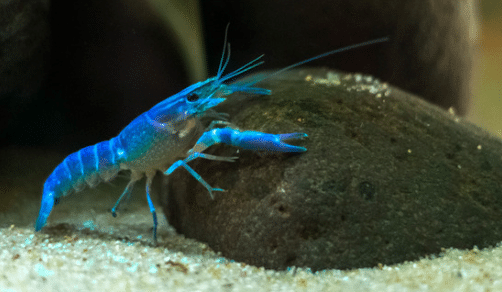
When setting up a crayfish tank, water parameters must be monitored closely in order to ensure the best environment and welfare of all its inhabitants. Ideally, pH levels should stay between 6.5 and 7.5 while temperature stays within 65-75°F (18-24 °C). Moderate water flow is suggested for most types of crayfish.
Tank size also plays an important role when it comes to selecting which species can inhabit the same aquarium with your pet crayfish. 55 gallons is considered enough space for species such as the Electric Blue Crayfish, although larger aquariums are recommended if more fish will join them too. Having said that, make sure everyone has an adequate amount of room so they may thrive without any impediments or overcrowding issues arising down the line.
Top Crayfish Tank Mates
After exploring the behavior of crayfish and creating their ideal aquatic environments, let’s check out our 15 top picks for the most compatible tank mates (and the video from our official Youtube Channel). I have a few points of emphasis I need to put down first before we get started:
- Any fish tankmate is a risk to a Crayfish – they all have a risk of being eaten
- The best way to prevent plants and fish getting harder with crayfish is to not keep fish at all with them
- Larger aggressive fish could seem like good choices as they won’t be targeted, but post molting Crayfish will be seen as potential prey!
We have selected these fish according to how well they will get along with crayfish, as well as satisfying appropriate water conditions that are perfect for them. All fish are at risk of being eaten or killed, but we have selected the ones with the smallest chances.
1. Other Crayfish

- Scientific Name: Procambarus spp
- Adult Size: 4 to 6 inches
- Water Temperature: 65°F to 75°F
- Minimum tank size: 40+ gallons
- Care Level: Moderate
- Diet – Omnivore
- Origin – Domestic
- Swimming Level – Bottom
If done correctly, having two crayfish from the same species in a tank can be possible. You’ll need to have plenty of room for multiple adult specimens and enough places for them to hide so as not to cause any territorial issues. At a minimum, a 4 foot tank is required to attempt.
Still, it is risky to house more than one due to their aggressive nature – always watch over them carefully and prepare yourself that you may eventually need to split them apart if disagreements occur or if an overly dominant individual is present. Males are more prone to exhibit aggressive behavior to their own kind1.
2. Zebra Danios
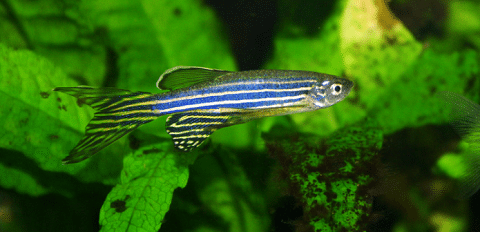
- Scientific Name: Danio rerio
- Adult Size: 2 to 2.5 inches
- Water Temperature: 72°F to 81°F
- Minimum tank size: 10 gallons
- Care Level: Easy
- Diet – Omnivore
- Origin – India
- Swimming Level – All
Zebra danios are popular schooling fish, well suited to living alongside crayfish. Their speed gives them an edge when it comes to dodging their tank mates, and they tend to stay close to the surface, so there is less chance of direct contact with bottom dwelling species like crayfish.
For beginning aquarists as well as experienced ones alike, these colorful little swimmers possess several appealing qualities – they’re easy keepers. Tolerant of a range of water parameters and eye catching in any setup! They also are admittingly cheap so they aren’t that bad to replace if they do happen to get eaten. They should be kept in larger numbers to feel secure around the Crayfish. They are about as safe as you can get when it comes to a crayfish tank mate.
3. Livebearers

- Scientific Name: Poecilia, Xiphophorus spp
- Adult Size: 2 to 5 inches
- Water Temperature: 64°F to 82°F
- Minimum tank size: 10 gallons
- Care Level: Easy
- Diet – Omnivore
- Origin – North/South America
- Swimming Level – Middle to Top
Tankmates for blue crayfish, such as guppies, mollies and swordtails, are suitable. As these fish reproduce quickly, they usually remain close to the surface of the tank, keeping them out of reach of their companion crustacean. Because of their tendency to produce many offspring, they can replenish their numbers.
You should keep your Crayfish well feed to keep them from just eating all your livebearers. They are at less risk then being eaten then others
4. Ricefish
Japanese rice fish are a commonly overlooked fish suitable for freshwater aquascapes. Very peaceful and hardy fish that color up with companions
- Scientific Name: Oryzias latipes
- Adult Size: 2 inches
- Water Temperature: 61°F to 75°F
- Minimum tank size: 10 gallons
- Care Level: Moderate
- Diet – Omnivore
- Origin – Japan, East Asia
- Swimming Level – Middle to Top
Ricefish, being quick and peaceful creatures, can usually avoid becoming food for crayfish. They can wander down to the bottom of the tank where it is more difficult for them to escape predation. Given their natural behavior of being around rice patties, floating plants are recommended to keep them at the top of the tank.
5. Pencilfish
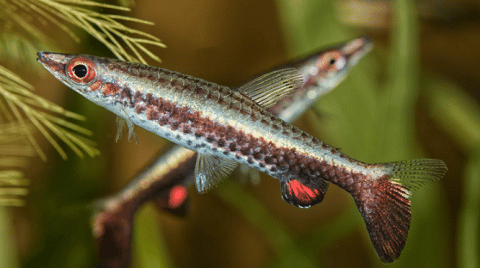
- Scientific Name: Nannostomus spp.
- Adult Size: 2 inches
- Water Temperature: 64°F to 82°F
- Minimum tank size: 10 gallons
- Care Level: Moderate
- Diet – Omnivore
- Origin – South America
- Swimming Level – Middle to top
Surface-dwelling fish like pencilfish are a great addition to an aquarium as they can avoid the presence of crayfish. These peaceful swimmers tend to stay near the top of the water where they won’t be targeted by these predators.
Feeding both species of aquatic animals is also easy, as pencilfish may not always consume food that has sunken to the bottom of the aquarium. This feed behavior keeps them out of harm’s way and allows you to feed both animals separately.
6. White Cloud Mountain Minnows
A very peaceful fish that does well in coldwater fish. Other minnow varieties are also available
- Scientific Name: Tanichthys albonubes
- Adult Size: 1.5 inches
- Water Temperature: 57°F to 72°F
- Minimum tank size: 10 gallons
- Care Level: Easy
- Diet – Omnivore
- Origin – China
- Swimming Level – Middle to top
White cloud mountain minnows are speedy fish that can usually live peacefully with crayfish. They tend to stay toward the middle or top of a tank, which helps them avoid confrontation. Still, it is important to observe their interactions closely in case any problems arise between these aquatic creatures.
By offering sufficient hiding places and keeping optimal water conditions, harmony should be maintained within your aquarium for all its inhabitants. Keep numbers high for them so they can feel comfortable around a predator like your crayfish.
7. Silver Dollars

- Scientific Name: Metynnis argenteus / Metynnis hypsauchen
- Adult Size: 6 inches
- Water Temperature: 72°F to 82°F
- Minimum tank size: 75 gallons
- Care Level: Easy
- Diet – Omnivore
- Origin – South America
- Swimming Level – Middle to top
Silver dollars are big fish that can get along with crayfish because of their size, speed, and habit to swim in schools. They enjoy staying together as a large group, which makes it hard for the crustaceans to target them as food. Being relatively large is another benefit when cohabitating with these aquatic creatures.
Adult silver dollars may reach up to 6 inches and are very fast, making them unappealing targets for potential predators such as crayfish. Despite this advantage, you should still pay attention. At the same time, they share an aquarium and make sure everything runs smoothly. A starving Crayfish will probably still try.
8. Goldfish
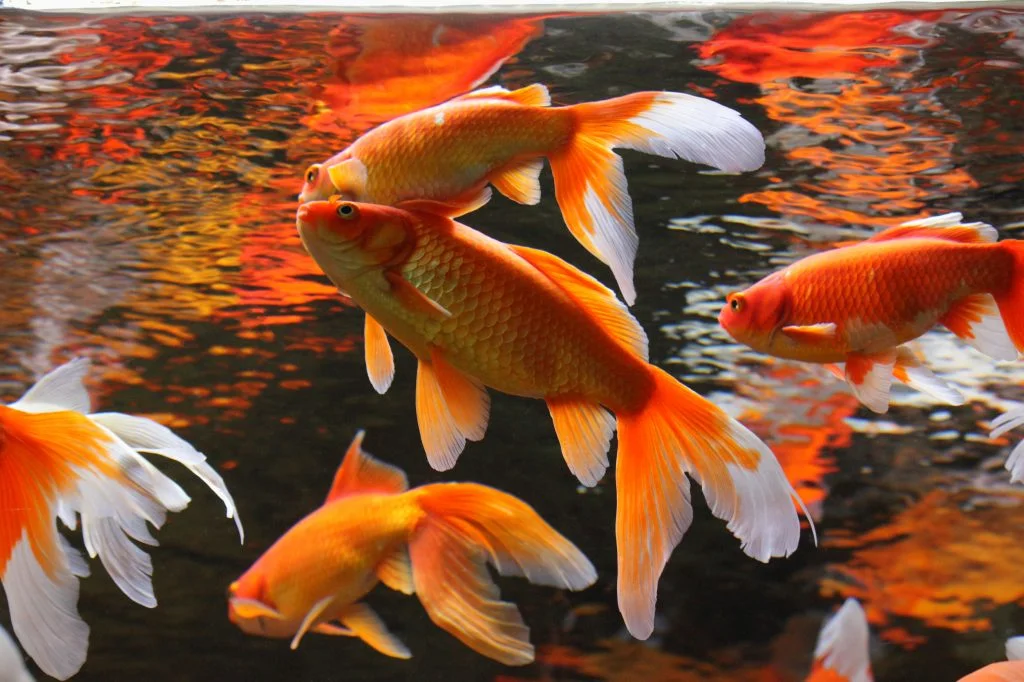
- Scientific Name: Carassius auratus
- Adult Size: 6+ inches
- Water Temperature: 60°F to 72°F
- Minimum tank size: 40 gallons
- Care Level: Easy
- Diet – Omnivore
- Origin – China
- Swimming Level – All, though mainly Middle
This is one of the most unlikely combinations, and at a glance, this seems like a recipe for disaster. After all, many fancy tail varieties are slow and hampered by their various genetic mutations that make them ill suited to be around a predator like a Crayfish.
However, with the right selection of breeds, goldfish are too bulky and fast to be a target. Here are some good picks if you want to attempt this combo:
Crayfish may view the slower swimming goldfish as a source of food, potentially putting them at risk of being caught, while the substrate scavenging by the goldfish will put them in view of the Crayfish. If you choose to take this route, it’s important that their environment be monitored regularly for signs of aggression. Always make sure you purchase goldfish that are larger than your Crayfish.
9. Hatchetfish
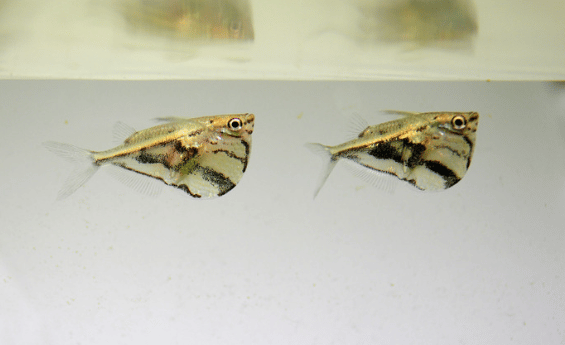
- Scientific Name: Gasteropelecus sternicla
- Adult Size: 1.5 inches
- Water Temperature: 72°F to 81°F
- Minimum tank size: 20 gallons
- Care Level: Moderate
- Diet – Omnivore
- Origin – South America
- Swimming Level – Top
Hatchetfish are surface-dwelling creatures, which should in concept keep them away from Crayfish. These fish typically stay near the top of a tank and will not attempt to eat food that sinks below the water’s surface – allowing you to feed both animals easily and keeping both within sight of each other.
Hatchetfish enjoy being in groups and should be kept in a large ground to feel secure.
10. Rainbowfish
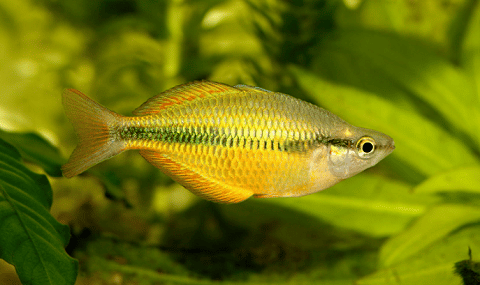
- Scientific Name: Melanotaenia spp.
- Adult Size:
- Water Temperature: 72°F to 77°F
- Minimum tank size: 40 gallons
- Care Level: Moderate
- Diet – Omnivore
- Origin – Indonesia
- Swimming Level – Middle
Tank mates such as rainbowfish can be compatible with crayfish in most scenarios. These fish are swift swimmers that usually stay near the top of the tank. They could unexpectedly end up close to where an aggressive crayfish resides, so it’s important to keep watch over their interactions.
To give them a safe haven from any dangers present at the bottom of said aquarium, plenty of hiding spots should also be made available for all occupants’ benefit. Rainbowfish also enjoy being in large schools so the larger the school, the less of a chance the Crayfish will have of snacking on the group.
Other Considerations
Here are other fish mentioned in other blogs on our YouTube channels I researched. I’ll list them and state the reasons why they are not listed.
- Red Tail Sharks – The red tail shark is large, but slow as it gets older
- Golden Wonder Killifish – Surface dweller, but not as safe as the other fish listed
- African Butterfly Fish – Good option requires a larger tank
- Tiger barbs – Too curious for their own good
- Bala Sharks – Requires very large tank
- Neon Tetras – Often cited. Less successful than Danios
- Cichlids – They are either too small and will get eaten or too large and aggressive that they will eat the Crayfish after it molts
Tips For A Successful Aquarium
Successfully maintaining a thriving tank full of crayfish and their companions requires ample attention to detail as well as an extensive comprehension of the specific needs for each species. By providing shelters, monitoring water parameters, and observing food intake habits, you can build a healthy environment conducive for your aquatic occupants.
Let’s go over a few factors to increase your chances of success.
Providing Hiding Spots
It is essential to build hiding spots in the crayfish tank to help reduce hostility and conflicts between its inhabitants. Crayfish are also noctural. If they don’t feel safe during the hide, they could get stressed out and eventually eat from the stress. These animals are meant to hide most of the day.
You can set up these hideaways using items from nature like rocks, driftwood, and plants, which will also make your aquarium more attractive while giving refuge to all animals inside it.
Maintaining Water Parameters
In order to provide the most suitable environment for crayfish and their tankmates, it is imperative that water parameters remain within acceptable levels. Regular testing of pH, temperature, and hardness should be conducted so adjustments can be made when necessary.
Regular partial water changes are essential practices as these crayfish can be messy when eating will help maintain optimal conditions in a community tanks.
Monitoring Feeding Habits
Monitoring the dietary intake of crayfish and their tankmates is absolutely essential to ensure everyone is receiving proper nutrition as well as avoiding competition or hostility over food. It’s important to observe how much you’re giving out, to variety, and make adjustments accordingly.
Be sure that anything not eaten by your aquatic companions gets removed from the aquarium before it has a chance to decompose and contaminate water quality levels, doing so will sustain an optimum living environment for all inhabitants including your beloved crayfish! By keeping watch on what they consume along with correct portion size management, things can stay healthy and vibrant within the confines of this artificial eco-system.
Frequently Asked Questions
Can crayfish live with cichlids?
No. Crayfish cannot be kept with Cichlids. With larger cichlids, they will tolerate each other and the crayfish will not see them as prey. However, when the crayfish molts they are vulnerable. During this time your larger cichlids will find the Crayfish irresistible and will try to eat it. For small cichlids, they hang around the bottom too much and are too small to be considered safe options. Your Crayfish will likely end up eating them.
Do crayfish and shrimp get along?
It is wise to not house crayfish and shrimp together because the former might view them as a meal. They should be kept in individual aquariums. This precaution ensures that both aquatic species can exist without fear of being preyed on or harassed by each other. Keeping these two kinds of creatures apart will maintain their safety and create an ideal environment for cohabitation between them.
Can I put a crayfish with my betta?
No. Crayfish are not compatible with Betta fish. Bettas are slow moving fish and while they generally are surface dwellers, they are easy prey to catch for crayfish. It would be better to house a Betta with a bamboo shrimp, which is large enough not to be considered prey yet peaceful enough not to try to eat the Betta.
What are some good tank mates for crayfish?
Crayfish are best with other crayfish if the tank is larger enough. Otherwise, all fish and shrimp are at risk of being eaten. That being said, the safest bets are Zebra danios, livebearers, and white cloud minnows.
How can I provide hiding spots for crayfish and their tank mates?
Adding rocks, driftwood, plants, and other decorations to an aquarium can create the perfect hiding spots for a crayfish and its tank mates.
Closing Thoughts
A captivating aquarium with diverse aquatic life can be created by paying attention to important details and providing suitable tankmates for crayfish. Key factors like understanding the behavior of these crustaceans, creating ideal habitats, and our top 10 recommended choices should all be considered to keep the risk of livestock being eaten to a minimum. It’s also essential to include hiding spots, keep water parameters consistent as well as monitoring their feeding habits, doing this will help maintain harmony within your tank!
- About the Author
- Latest Posts
I’m thrilled that you found Aquarium Store Depot! Here you’ll find information on fish, aquariums, and all things aquatics related. I’m a hobbyist (being doing this since I was 11) and here to help other hobbyists thrive with their aquariums! I adhere to a high quality Editorial Process and Review products with real life field usage and practical analysis.

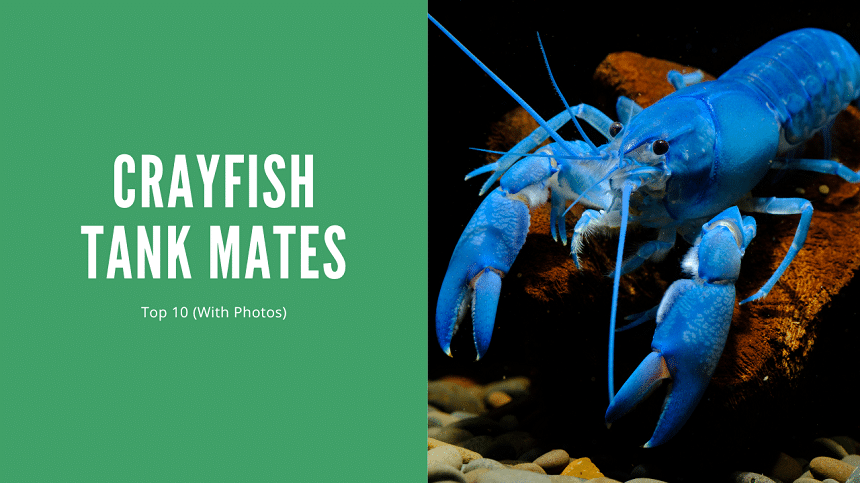
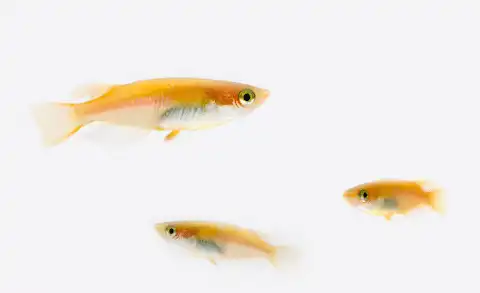





so sigma man